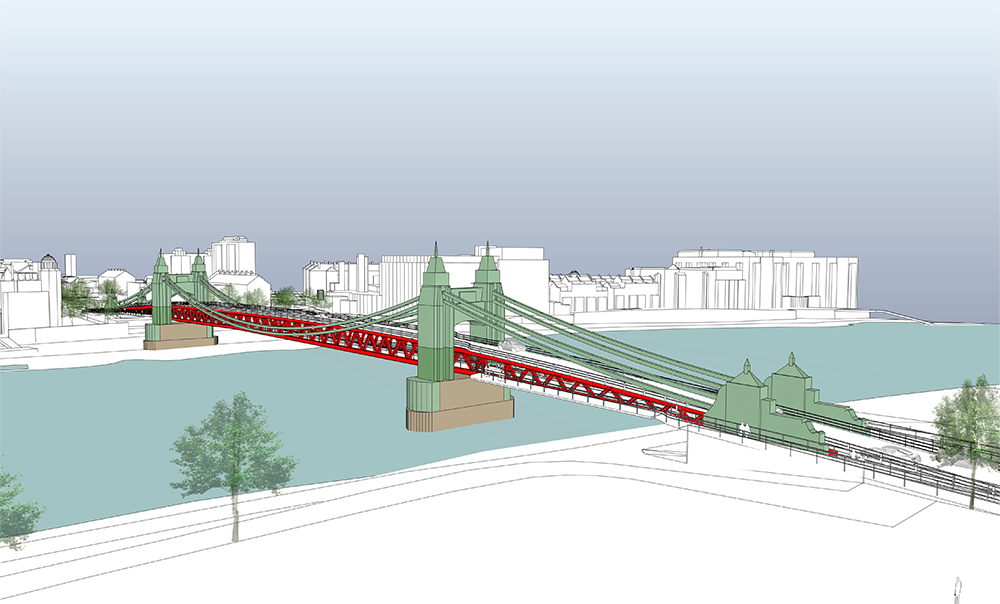
Artist's impression of the temporary crossing installed and the existing deck removed. PICTURE: FOSTER + PARTNERS/COWI
- Foster + Partners/COWI truss design can use existing foundations.
- £40m could be cut from cost of full repair and restoration programme.
- H&F proposes toll of motorists to fund bridge repairs.
- Report on pedestals due next month.
Hammersmith Bridge could potentially reopen for pedestrians and cyclists next summer, and motor vehicles two months later, under radical plans presented to Hammersmith & Fulham Council.
A six-week long technical study conducted jointly by world-leading architects and engineers Foster + Partners, and bridge engineers COWI, has concluded that a temporary double-decker crossing is feasible using the existing bridge foundations. This is an exciting option which Hammersmith & Fulham Council is exploring further alongside other options.
As well as delivering vehicle access earlier than the current restoration plan, the proposal has been initially costed at around £100m - offering a potential saving of approximately £40m.
The double-decker scheme would involve launching a truss structure above the existing road deck with a lower level for pedestrians and cyclists and an upper level for cars and buses.
H&F Leader Cllr Stephen Cowan and Foster + Partners/COWI will discuss the findings of the feasibility study at next week’s meeting of the Government’s Hammersmith Bridge Taskforce.
The council has also submitted an Outline Financial Plan to the Secretary of State for Transport, Grant Shapps MP, for the bridge restoration work to be funded through a toll or road charging scheme and is currently awaiting the Government’s response.
Early assessments indicate that motorists might pay an average of £3 to drive across the 134-year-old bridge, the ownership of which could be transferred to a charitable trust.
Cllr Cowan said: “Hammersmith Bridge is one of the oldest suspension bridges in the world and the most expensive in Britain to repair.
“So, while we’re working to fully restore the bridge as quickly as possible, we’re also determined to put in place the necessary governance and long-term funding arrangements that will make sure it is properly maintained well into the next century.”
The bridge has had four separate owners during its lifetime. Until 1985, when its ownership was handed to H&F, maintenance funding had always been directly linked to the receipt of the London transport fare revenues. The current administration will spend a record £8.6m maintaining Hammersmith Bridge.
Cllr Cowan added: “We are proposing a twin-track solution which reunites maintenance funding with transport use and puts the bridge into a charitable trust, similar to the Bridge House Trust that cares for five of London’s most historic bridges.”
The temporary double-decker bridge
The Grade II* listed bridge was closed to pedestrians and cyclists on public safety grounds on 13 August 2020 after cracks in the cast iron pedestals widened during a heatwave.
After the closure, Cllr Cowan met with Sir John Ritblat who approached Foster + Partners and specialist bridge engineers COWI to develop a plan. In November they unveiled a radical and encouraging new plan to build a temporary double-decker crossing within the existing structure of Hammersmith Bridge. Subsequently H&F commissioned a feasibility study into that proposal at a cost to the borough of £200,000.
That study has now confirmed that the existing foundations could support the extra load of the temporary truss and that significant savings could be made on both the support and strengthening work required to the existing bridge and the cost of the full restoration. The council is now looking into this approach further alongside other options.
Elements of the bridge that need repair, including the decking, would be lifted away using the temporary bridge as a works platform and transported by barges to an off-site facility for safe repair and restoration.
Historic England, which has been already been involved in discussions about the plan, will need to approve the works which enable the bridge to be restored to its original Victorian splendour with fewer constraints.
According to the feasibility report, provided planning and procurement is in place by the end of this year, the bridge could reopen for pedestrians and cyclists by the summer of 2022 and motor vehicles two months later, four years sooner than the current plan. The full restoration could be completed in 2023.
Roger Ridsdill Smith, Head of Structural Engineering at Foster + Partners, said:
“The feasibility study supports the technical viability of the proposed temporary crossing, showing it that it has the potential to be significantly cheaper than a scheme that repairs the bridge in situ. It also offers the possibility of the bridge reopening earlier than previously envisaged. The feasibility study was expedited by the extensive investigations and analysis already carried out on the existing structure and we are grateful for the cooperation of all of the parties involved.”
David MacKenzie, Executive Director at COWI, said:
“Offsite refurbishment of the existing structure is considered to be safer, less disruptive and more sustainable. Carrying out the work in internal protected conditions rather than onsite - outside and over the river - will enable us to achieve a higher quality of workmanship and reduce the need for extensive maintenance in the future.”
Funding the repairs through a toll
In November 2020, the council was asked by the Secretary of State to pay at least £64m or 50 per cent of the cost of the stabilisation and strengthening works required to safely reopen the bridge.
Cllr Cowan explained: “It was unprecedented for a small borough council to pay such a large sum especially when Hammersmith Bridge largely benefits Londoners who live outside the borough mostly south of the river.”
H&F submitted its Outline Financial Plan to the Secretary of State on 19 February. This outlined the options available to procure and fund the repair of the bridge, including a toll or road charge.
On the basis of the work completed to date, H&F’s emerging preference is to establish a Charitable Trust similar to the Bridge House Estates (a charitable trust established by royal charter in 1282) which owns and maintains five of London’s most important bridges: Blackfriars Bridge, Southwark Bridge, London Bridge, Tower Bridge and the Millennium Bridge.
The road charge could be raised using the same automatic number plate recognition technology as the London congestion charge. The Government has been asked to fund the costs of the borrowing, stabilisation and any other upfront costs in the period prior to the road charging taking effect.
The level of Government support would also dictate the toll or charge, with significant funding potentially reducing the toll.
Progress on engineering work
Mott McDonald, the specialist engineers currently engaged by H&F to work on the bridge, are completing the assessment work on the western side of the bridge following the removal of the outer casings and the blast cleaning of the two remaining pedestals.
The previous report by Motts received in January detailed how the innovative temperature control system commissioned by H&F last summer at the annual cost of £420,000 has been a success and “provides some mitigation” by moderating the load on the pedestals. That report is now the subject of an independent “Category 3” check, carried out by specialist engineers from a different company.
Motts are expected to submit a new report in April to H&F detailing the conclusions of its latest pedestal investigations. The report will then be reviewed by the Board for the Continued Case for the Safe Operation of Hammersmith Bridge.
If at that stage a decision is taken to prepare for any safe re-opening of the bridge, this could be achieved alongside the repair and restoration bridge programme, including that put forward by Foster + Partners/ COWI.
Background
- The original £141m repair bill is significantly more expensive to fix in comparison to other London bridges, in large part, because it is held in place using unusual materials such as cast iron (which can shatter), wrought iron, and wood. Its suspension mechanisms are unique. For example, in 2013/14 the Royal Borough of Kensington and Chelsea paid £2.6m towards the repair of Albert Bridge but TfL contributed the bulk, paying £7.1m. Chiswick Bridge recently cost £9m to refurbish but those works were fully paid for by TfL. Wandsworth Council is paying for the refurbishment of Wandsworth Bridge but those works are only costing around £6m.
- Data from the Ministry for Housing, Communities and Local Government details how, since 2010, only £100m in total has been spent by London boroughs on maintenance and repair of all London road and river bridges – equivalent to less than £400,000 per year for each borough. Even then, most of that money was eventually paid by TfL or Government.
- Since 2010 the government has cut H&F’s total annual net budget from £184.345m to £124.458m this year. Even taking a loan would cost millions of pounds in annual repayments and cause significant cuts to local services or huge rises in council tax – things the council says it cannot allow to happen.
- H&F and TfL applied to Government for funding for the works on Hammersmith Bridge on three separate occasions: December 2019, February 2020, and June 2020. All three bids were rejected.
Want to read more news stories like this? Subscribe to our weekly e-news bulletin.




